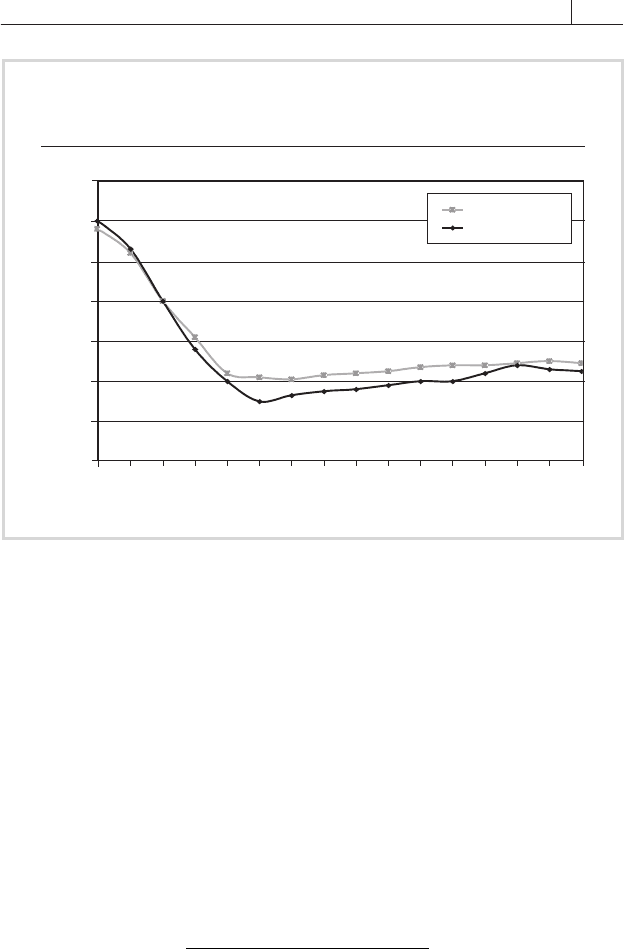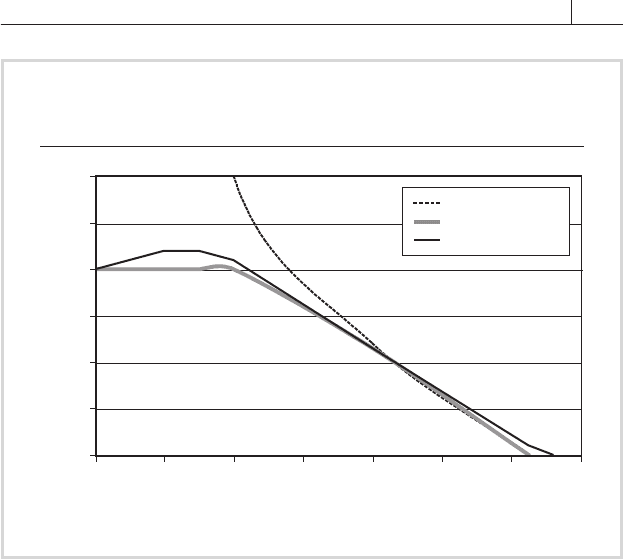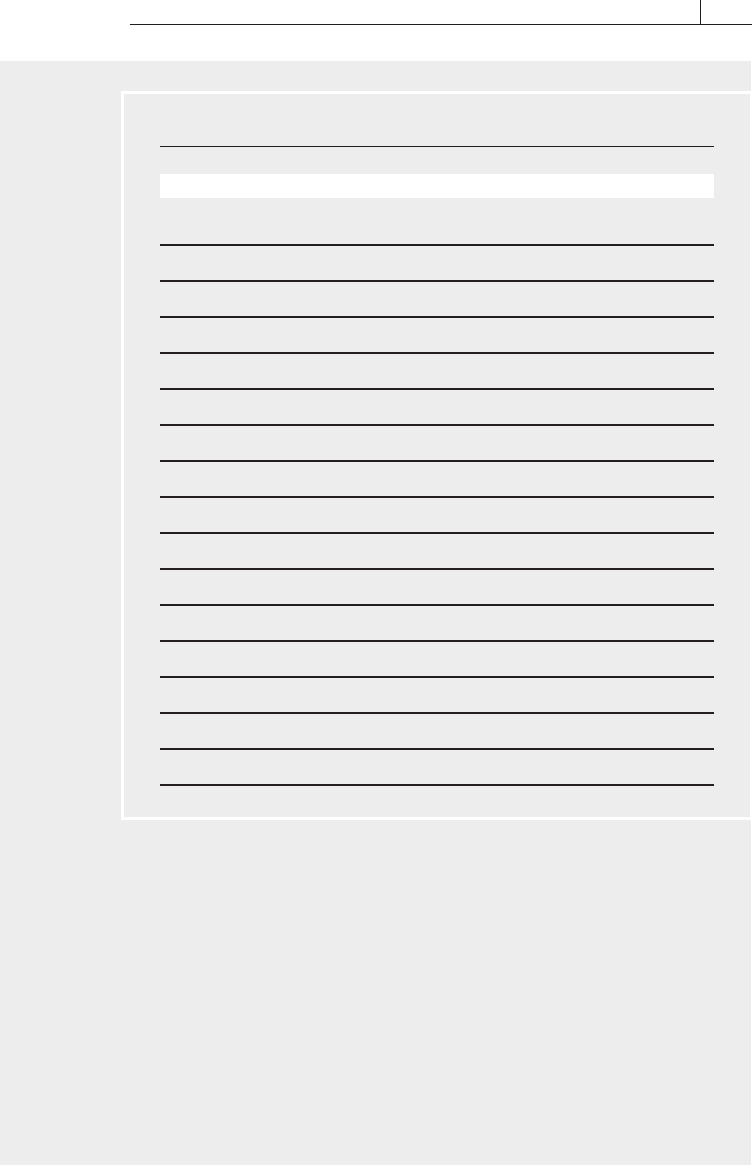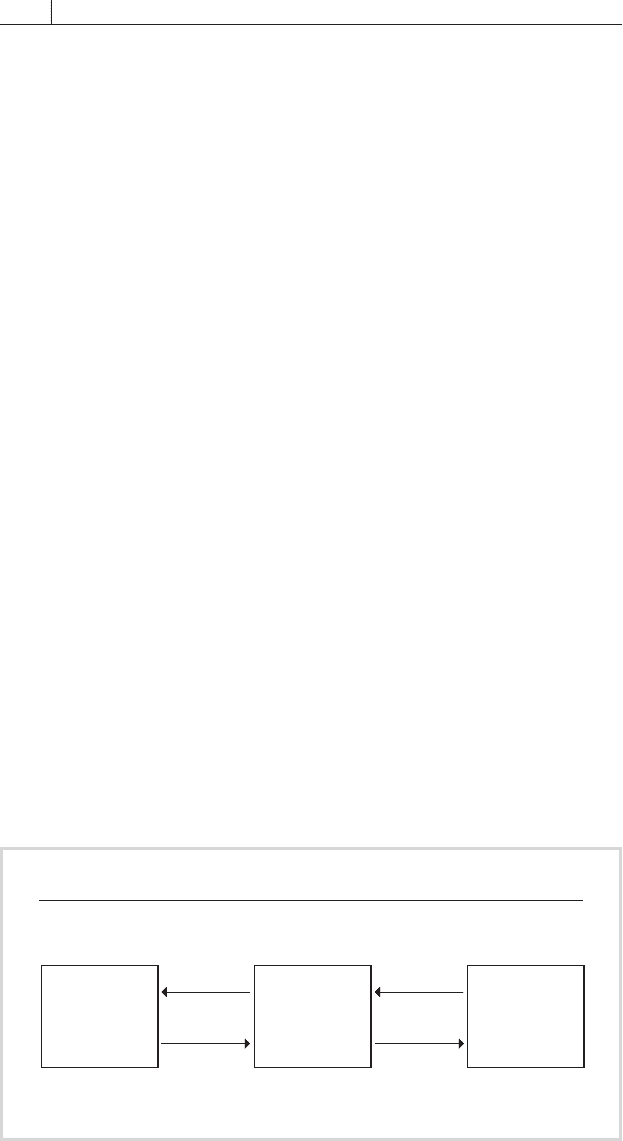Choudhry. Fixed Income Securities Derivatives Handbook
Подождите немного. Документ загружается.


272 Selected Cash and Derivative Instruments
D
PP
Prm
app
=
−
()
−+
2
0
∆
(14.19)
where
P
0
= the initial price of the bond
∆rm = the change in the yield of the bond
P
–
= the estimated price of the bond if the yield decreases by ∆rm
P
+
= the estimated price of the bond if the yield increases by ∆rm
Effective duration is essentially approximate duration where P
–
and P
+
are obtained using a valuation model—such as a static cash fl ow model,
a binomial model, or a simulation model—that incorporates the effect
of a change in interest rates on the expected cash fl ows. The values of
P
–
and P
+
depend on the assumed prepayment rate. Generally analysts
assume a higher prepayment rate when the interest rate is at the lower level
of the two rates—interest and prepayment.
FIGURE 14.6 illustrates how effective duration—calculated using a 20
basis point change in rates—differs from modifi ed duration for agency
mortgage pass-through securities with a range of coupons. It shows that
modifi ed duration overestimates the price sensitivity of lower-coupon
bonds. This difference has a signifi cant effect when hedging a mortgage-
backed bond position: using modifi ed duration to calculate the needed
nominal value of a hedging instrument will be accurate for only very small
changes in yield.
The formula for calculating approximate convexity is (14.20). If P
–
and
P
+
are obtained using a valuation model that incorporates the effect of a
change in interest rates on the expected cash fl ows, the equation derives
effective convexity. The effective convexity of a mortgage pass-through
security is invariably negative.
CV
PP P
Prm
app
=
+−
()
+−
2
0
0
2
∆
(14.20)
Total Return
To assess the value of a mortgage-backed bond over a given investment
horizon, it is necessary to measure the return generated during the hold-
ing period from the bond’s cash fl ows. This is done using the total return
framework.
Computing total return starts with calculating total cash fl ows. A
mortgage-backed bond’s cash fl ows comprise:
❑ its projected interest payments and principal repayments and pre-
payments

Securitization and Mortgage-Backed Securities 273
❑ the interest earned by reinvesting all the payments
❑ the bond’s projected price at the end of the holding period
The fi rst component can be estimated by assuming a prepayment
rate during the holding period; the second entails assuming a reinvest-
ment rate. For the third, two assumptions are necessary: one concerning
the bond’s bond-equivalent yield at the end of the holding period, and
another about the prepayment rate projected by the market at this point,
which is a function of the projected yield.
Plugging the total cash fl ow fi gure into equation (14.21) gives the
bond’s total return for the holding period, on a monthly basis.
TR =
Total future cash flow amount
P
m
n
⎡
⎣
⎢
⎤
⎦
⎥
−
1
1
/
(14.21)
where
P
m
= initial investment
n = number of months in the holding period
The monthly return can be converted to an annualized bond-equiva-
lent yield using formulas (1.24a) or (b), as discussed in chapter 1.
FIGURE 14.6
Modified and Effective Duration of Agency
Mortgage-Backed Bonds
Coupon
Duration
Modified duration
Effective duration
0
1
2
3
4
5
6
7
5.5 6.0 6.5 7.0 7.5 8.0 8.5 9.0 9.5 10.0 10.5 11.0 11.5 12.0 12.5 13.0

274 Selected Cash and Derivative Instruments
The return calculated using (14.21) is based on several assumptions.
The best way to obtain an idea of the return likely to be generated over the
holding period is to compute a range of returns by using a range of values
for each assumption.
Price-Yield Curves of Mortgage Pass-Through, PO, and
IO Securities
When interest rates are high, holders of mortgage-backed bonds want
prepayments to occur. This is because the rate paid by the underlying
mortgages, and thus by their bonds, are lower than those available in the
market and the likelihood of mortgage prepayment at par boosts their
bonds’ value. Conversely, when interest rates are low, bondholders prefer
no prepayments, since their bonds’ interest rate is higher than that avail-
able in the market and their value correspondingly high.
FIGURE 14.7
illustrates how the price of a pass-through security with a nominal coupon
of 7 percent behaves under different prepayment scenarios at different
market yields.
When no prepayments are made, cash fl ows are certain and the pass-
through’s price and yield behave like those of a conventional bond. At
an optimal prepayment rate—that is, one based on the assumption that
homeowners act rationally and refi nance whenever they can reduce their
mortgage costs by an amount greater than the refi nancing transaction’s
cost—the bond acts like a callable bond: when interest rates are high, it
resembles a plain vanilla bond; when rates are lower, its price is capped
at par. Under what Tuckman (1996) calls “realistic payment” conditions,
the price behavior is somewhat different. First, when rates are very low,
the bond’s price is higher than in the other two scenarios. This is because
a number of mortgage borrowers do not act “optimally,” repaying their
loans irrespective of the level of interest rates—even when they’re high;
since prepayments at high rates are good for bondholders, the bond prices
in the realistic scenario are higher at this end of the yield spectrum than
are those for the other two models, which predict no prepayments under
these conditions.
Second, when interest rates are very low, the bond’s price is higher
under the realistic scenario than under the optimal one, though not
as high as in the no-prepayment model. The reason is that, in this en-
vironment, many borrowers will behave “optimally” and prepay their
loans, but by no means all will. Since prepayments decrease the value
of a mortgage bond when rates are low, the fact that not all borrowers
prepay in the “realistic” scenario results in the realistic-prepaid value
of a mortgage bond being somewhat greater than its optimal-prepaid
value. This nonprepayment behavior can lead to the bond being valued

Securitization and Mortgage-Backed Securities 275
above par. This is something of an anomaly, considering that the bond
is then priced above the level at which it can theoretically be called.
Eventually, though, rates fall far enough to convince all borrowers to
redeem their loans, and the realistic-prepayments curve moves down
to par.
Figure 14.7 demonstrates the negative convexity of mortgage bonds
through the fact that their prices fall as interest rates decline. This does
not mean that investors should avoid mortgage-backed bonds in this en-
vironment. As Tuckman (1996) notes, mortgage bonds in this situation
are paying rates higher than those available elsewhere in the market, par-
ticularly the debt market. The relevant consideration is total return over
the holding period, not price. Making investment decisions based on price
behavior alone, Tuckman writes (page 256), is “as bad as concluding that
premium Treasuries should never be purchased because they will eventu-
ally decline in price to par.”
As already discussed, IOs, which receive the interest payments of the
underlying collateral, and POs, which receive principal payments, exhibit
different price behavior from pass-throughs and from each other. Figure
14.5 (page 263) showed that when interest rates are very high and prepay-
ments, accordingly, unlikely, POs act as if repayable at par on maturity,
like zero-coupon bonds. When interest rates decline and prepayments
FIGURE 14.7
Price Behavior of a 7 Percent Coupon Pass-
Through for Different Prepayment Scenarios
10-year par yield (%)
Price
60
70
80
90
100
110
120
1 3 5 7 9 11 13 15
No prepayments
Optimal prepayment
Realistic prepayment

276 Selected Cash and Derivative Instruments
CASE STUDY: ACE Securities Corp. Home Equity Loan Trust,
Series 2004
1
Residential MBSs are characterized as prime and sub-prime, de-
pending on the credit quality of the underlying mortgages. A credit
quality score known as FICO measures whether the loan is prime
or sub-prime. Home equity, while previously referring to a different
type of RMBS, now refers to a sub-prime RMBS transaction.
ACE Securities series 2004 is a sub-prime RMBS transaction
that closed in the U.S. market in January 2004. It is a securiti-
zation of a pool of sub-prime mortgages originally on the balance
sheet of Fremont Investment and Loan. Fremont is a commercial
banking institution that had been engaged in sub-prime mort-
gage lending for more than ten years prior to the transaction,
and also originated previous home equity securitization deals.
Transaction Summary
Originator Fremont Investment & Loan
Type Senior subordinated residential MBS
Amount $751,303,000
Credit support Note tranching, overcollateralization, excess
spread
Servicer The Provident Bank
Trustee
HSBC Bank USA
Underwriter Deutsche Bank Securities
The tranche structure for ACE Securities HELT series 2004 is
shown in
FIGURE 14.8. The transaction was undertaken to provide
a diversifi ed funding source for Fremont, with a size of more than
$751 million.
The deal is structured as a senior-subordinated overcollateraliza-
tion, with the fi rst three notes all rated as AAA. These are ranked fur-
ther into a super-senior and junior-senior tranche. The note tranching
is the principal form of credit enhancement, in addition to the
overcollateralization of 0.85 percent. There is also a reserve account
to trap excess spread, which is a further credit enhancement.
The Class A-1 notes also have credit enhancement from Class
A-3. This works as follows: where the subordinated notes are
reduced to zero, any losses on the underlying pool of mortgages

Securitization and Mortgage-Backed Securities 277
Source: Moody’s. Reproduced with permission
supporting the notes that are not covered by the overcollateraliza-
tion and the excess spread will be borne by the A-3 notes ahead of
the A-1 notes.
This transaction features an unusual feature in that the underly-
ing pool of mortgages is split into two groups, Loan Groups 1 and
2. Classes A-1 and A-3 are supported by Loan Group 1, and classes
A-2A, A-2B, and A-2C are supported by Loan Group 2; however,
there is also cross-collateralization for the senior notes.
This is an interesting structure but nevertheless represents a
routine transaction in the highly developed U.S. MBS market.
FIGURE 14.8
ACE Securities Corp. HELT Series 2004-FM1
CLASS DESCRIPTION AMOUNT $000 COUPON RATING
A-1 Super senior principal & interest 571,643 LIBOR + 0.30 Aaa
A-2A Senior principal & interest 37,604 LIBOR + 0.32 Aaa
A-2B Senior principal & interest 39,000 LIBOR + 0.19 Aaa
A-2C Senior principal & interest 19,127 LIBOR + 0.46 Aaa
A-3 Junior senior principal & interest 63,516 LIBOR + 0.40 Aaa
M-1 Subordinate principal & interest 69,547 LIBOR + 0.60 Aa2
M-2 Subordinate principal & interest 57,128 LIBOR + 1.25 A2
M-3 Subordinate principal & interest 17,387 LIBOR + 1.45 A3
M-4 Subordinate principal & interest 17,387 LIBOR + 1.80 Baa1
M-5 Subordinate principal & interest 14,903 LIBOR + 1.95 Baa2
M-6 Subordinate principal & interest 9,935 LIBOR + 3.50 Baa3
B-1A Subordinate principal & interest 6,955 LIBOR + 3.50 Ba2
B-1B Subordinate principal & interest 6,955 6.00% Ba2
CE Residual – Not rated
P Prepayment penalties – Not rated
R Residual – Not rated

278 Selected Cash and Derivative Instruments
increase, the POs’ price increases. Other factors are at work, however, that
make PO prices highly volatile. These are:
❑ the hypersensitivity of POs to the conventional price/yield effect,
which states that lower interest rates cause higher prices and vice
versa
❑ the effect on POs’ maturity of prepayment rates—specifi cally, the
higher the actual and expected rates, the lower the effective matu-
rity and, so, the higher the POs’ price
IOs’ price/yield relationship is a function of that for POs, obtained by
subtracting the value of the latter from that of the underlying mortgage
pass-through. IOs’ prices are very volatile when interest rates are low and
falling. This may be explained as follows: when rates are high and prepay-
ments very low, IOs’ cash fl ows are known with virtual certainty, so they
act like plain vanilla bonds. When rates fall and prepayments rise, dimin-
ishing the nominal amount of the mortgages on which interest is charged,
IOs’ cash fl ows effectively disappear because, unlike pass-throughs and
other mortgage securities, they don’t receive any principal payments. Their
prices in these circumstances decline dramatically. Such negative duration
makes IOs attractive to market makers in mortgage-backed securities as
interest-rate hedging instruments.
Chapter Notes
1. The information source for this case study is Moodys, Inc. and is used with permission.
The author thanks Andrew Lipton and Paul Kerlogue at Moodys and Serj Walia at KBC
Financial Products for their kind assistance when preparing this case study.

279
CHAPTER 15
Collateralized Debt Obligations
C
ollateralized bond obligations (CBOs) and collateralized loan
obligations (CLOs), which together make up collateralized debt
obligations (CDOs), are among the newest developments in
securitization. The instruments are generally held to have originated in the
repackaging of high-yield debt or loans into higher-rated bonds that began
in the late 1980s. Today many types of CDOs exist, and the market has
expanded from the United States into Europe and Asia.
Both CBOs and CLOs are securities issued against an underlying col-
lateral of assets. These assets almost invariably are diverse corporate bonds
or loans or both. CBOs are backed by corporate or sovereign bonds;
CLOs, by secured and/or unsecured corporate and commercial bank
loans. There are two types of CDOs: arbitrage and balance sheet. Some
analysts also recognize a third category: emerging market CDOs, which are
CDOs securitized from a portfolio of emerging market bonds (or loans).
A typical CDO structure involves the transfer of the credit risk associ-
ated with an underlying asset pool from the originating institution to a
special purpose vehicle, or SPV, created specifi cally to make this transfer
possible. The SPV—typically bankruptcy remote and isolated from the
originator’s credit risk, often in a tax haven—then transfers the risk to in-
vestors by issuing CDO notes. The return to investors in the issued notes
depends on the performance of the underlying asset pool. The manager,
who is responsible for managing the portfolio of underlying assets and
bonds, would be expected to manage the portfolio after the CDO trans-
action is brought to market. As the bonds in the underlying portfolio

280 Selected Cash and Derivative Instruments
might need to be hedged (to remove risk exposure arising from issuing a
series of notes that have different interest pay dates and also possibly dif-
ferent currencies), an interest rate and currency swap is entered into with
a hedge counterparty.
Among institutions’ objectives in originating CDO transactions are
the following:
❑ Optimizing their returns on regulatory capital, by reducing
the need for capital to support assets on the balance sheet. Regulatory
capital is the capital needed to be put up by a fi nancial institution in
accordance with the “Basel” rules, issued by the Bank for International
Settlement.
❑ Improving their returns on economic capital, the actual capital
used by the bank to support its operations, by managing risk effectively
❑ Managing their credit risk and balance sheets
❑ Issuing securities as a means of funding
❑ Gaining funding for acquiring assets
❑ Increasing funds under management
FIGURE 15.1 shows a typical conventional CDO structure.
As noted above, CLOs are backed by pools of bank loans and CBOs
by portfolios of bonds. The two types of underlying assets differ in ways
that affect the analyses of the securities they collateralize. Among the
differences are the following:
❑ Loans have less uniform terms than bonds, varying widely in
their interest dates, amortization schedules, reference indexes, reset dates,
maturities, and so on. How their terms are defi ned affects the analysis of
cash fl ows.
❑ In part because of this lack of uniformity, the legal documentation
for loans is less standardized than that for bonds. Securities backed by
loans, therefore, require more in-depth legal review.
FIGURE 15.1
A Typical Conventional CDO Structure
Issue proceeds
Funds
Originator
SPV
Investors
NotesIssue portfolio
CLNs

Collateralized Debt Obligations 281
❑ It is often possible to restructure a loan portfolio to refl ect the
changed or changing status of the borrowers—for example, their ability to
service the debt. This provides participants in a CLO with more fl exibility
than they usually have with a CBO.
❑ The market in bank loans is far less liquid than that in bonds,
which has the effect of making overlying notes sometimes less liquid in the
secondary market for CLOs.
CDO Structures
CDO structures may be either conventional or synthetic. The conven-
tional structures were the fi rst to be widely used, but synthetic ones
have become increasingly common since the late 1990s. The difference
between the two structures lies in how they transfer credit risk from the
originator to the SPV: in conventional CDO structures, this is achieved
by transferring assets; in synthetic structures, credit derivative instru-
ments are used.
CDOs of both types are also categorized by the motivation behind
their creation. The two main categories are issuer- or balance sheet–driven
transactions and investor-driven or market value arbitrage transactions.
Conventional CDO Structures
In a conventional structure, such as the one illustrated in
FIGURE 15.2,
the creation of an SPV usually involves the transfer from the originator
of a nominal amount of equity. The main funding comes from issuing
CDO notes. The proceeds from the issuance are used to acquire the
pool of underlying assets (bonds or loans) from the originator in what
is known as a true sale. If performed and structured properly, this asset
transfer removes assets from the regulatory balance sheet of a bank origi-
nator. As a result, the securitized assets are not included in the calcula-
tion of the bank’s capital ratios. This provides regulatory capital relief,
which is the main motivation for many of the CDO transactions in the
market today.
Because the SPV now owns the assets, it has an asset-and-liability
profi le that must be managed during the term of the CDO. The typical
liability structure includes a senior tranche rated Aaa/Aa, a junior tranche
rated Ba, and an unrated equity tranche. The equity tranche is the riskiest,
since it is the fi rst to absorb any losses in the underlying portfolio. For this
reason, it is often referred to as the fi rst-loss tranche.
In the case of a CLO, the originating bank commonly continues to
service the underlying loan portfolio and retains the equity tranche.
This is done for the following reasons:
